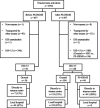Impact of a physician-staffed helicopter on a regional trauma system: a prospective, controlled, observational study
- PMID: 23289798
- PMCID: PMC3652037
- DOI: 10.1111/aas.12052
Impact of a physician-staffed helicopter on a regional trauma system: a prospective, controlled, observational study
Abstract
Introduction: This study aims to compare the trauma system before and after implementing a physician-staffed helicopter emergency medical service (PS-HEMS). Our hypothesis was that PS-HEMS would reduce time from injury to definitive care for severely injured patients.
Methods: This was a prospective, controlled, observational study, involving seven local hospitals and one level I trauma centre using a before and after design. All patients treated by a trauma team within a 5-month period (1 December 2009-30 April 2010) prior to and a 12-month period (1 May 2010-30 April 2011) after implementing a PS-HEMS were included. We compared time from dispatch of the first ground ambulance to arrival in the trauma centre for patients with Injury Severity Score (ISS) > 15. Secondary end points were the proportion of secondary transfers and 30-day mortality.
Results: We included 1788 patients, of which 204 had an ISS > 15. The PS-HEMS transported 44 severely injured directly to the trauma centre resulting in a reduction of secondary transfers from 50% before to 34% after implementation (P = 0.04). Median delay for definitive care for severely injured patients was 218 min before and 90 min after implementation (P < 0.01). The 30-day mortality was reduced from 29% (16/56) before to 14% (21/147) after PS-HEMS (P = 0.02). Logistic regression showed PS-HEMS had an odds ratio (OR) for survival of 6.9 compared with ground transport.
Conclusions: Implementation of a PS-HEMS was associated with significant reduction in time to the trauma centre for severely injured patients. We also observed significantly reduced proportions of secondary transfers and 30-day mortality.
© 2013 The Acta Anaesthesiologica Scandinavica Foundation.
Figures


References
-
- MacKenzie EJ, Rivara FP, Jurkovich GJ, Nathens AB, Frey KP, Egleston BL, Salkever DS, Scharfstein DO. A national evaluation of the effect of trauma-center care on mortality. N Engl J Med. 2006;354:366–378. - PubMed
-
- Garwe T, Cowan LD, Neas BR, Sacra JC, Albrecht RM. Directness of transport of major trauma patients to a level I trauma center: a propensity-adjusted survival analysis of the impact on short-term mortality. J Trauma. 2011;70:1118–1127. - PubMed
-
- Nirula R, Maier R, Moore E, Sperry J, Gentilello L. Scoop and run to the trauma center or stay and play at the local hospital: hospital transfer's effect on mortality. J Trauma. 2010;69:595–599. - PubMed
-
- Meisler R, Thomsen AB, Abildstrøm H, Guldstad N, Borge P, Rasmussen SW, Rasmussen LS. Triage and mortality in 2875 consecutive trauma patients. Acta Anaesthesiol Scand. 2010;54:218–223. - PubMed
-
- Krüger AJ, Skogvoll E, Castrén M, Kurola J, Lossius HM. Scandinavian pre-hospital physician-manned Emergency Medical Services–same concept across borders? Resuscitation. 2010;81:427–433. - PubMed
Publication types
MeSH terms
LinkOut - more resources
Full Text Sources
Other Literature Sources
Medical
Miscellaneous

